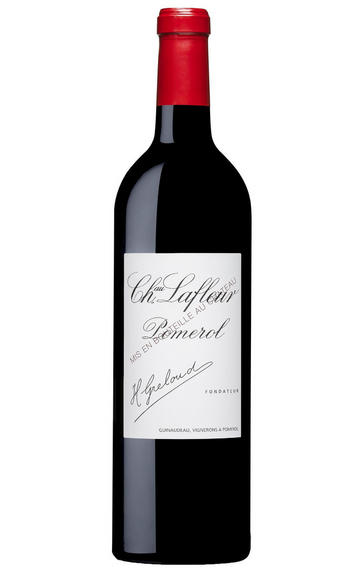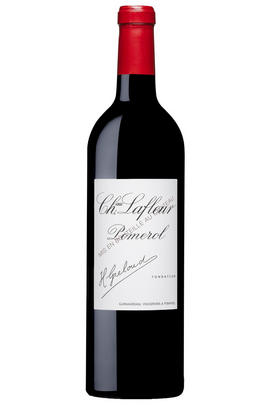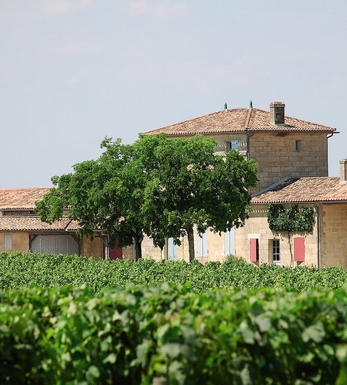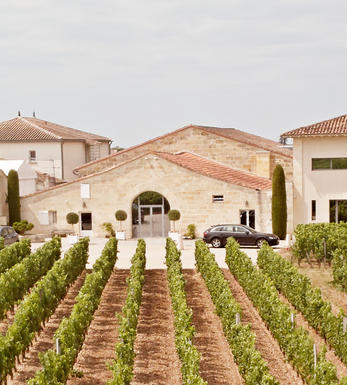
2018 Château Lafleur, Pomerol, Bordeaux

Critics reviews
The first thing to say about the 2018 Lafleur is that it is completely different from the Les Pensées and in fact is more similar to Guinaudeau’s Les Perrières, which is unsurprising given that both come from stony soils (limestone there, gravel here) whereas Les Pensées comes from more clayey soils. This has a very refined bouquet, the blue fruit that I picked up from barrel receding to make way for more red fruit, cranberry and even touches of pomegranate.
Monitoring this half-bottle over 24 hours, the Pomerol traits of black truffle and a faint scent of morels gradually emerge. The palate is medium-bodied with fine tannins that frame the red berry fruit. The Bouchet (Cabernet Franc), which comprises 54% of the blend, imparts a wonderful peppery note that lingers 45 seconds after the wine has exited, the tongue tingling long after it says goodbye. At just under 15% alcohol, one might expect a little warmth on the finish, but it is not detectable. A superb Lafleur, albeit one that will demand several years’ cellaring.
Drink 2026 - 2060
Neal Martin, Vinous.com (March 2021)
The 2018 Lafleur is mesmerizing. What a wine! The aromatics alone are spellbinding. There is no need to actually taste the 2018 to know how profound it is. Silky and caressing, with phenomenal persistence, the 2018 is a total knock-out. Spice, cedar, blood orange, sage, mint, rose petal and kirsch all race out of the glass, saturating the palate with a dazzling concoction of aromas, textures and flavors. Readers lucky enough to find it should not hesitate.
Drink 2028 - 2058
Antonio Galloni, Vinous.com (March 2021)
Hold +5 years
Always a wine that requires time in bottle, and the 2018 is extremely closed down at three years old. Cabernet Franc dominates in expression, with layers of cool blueberry and blackcurrant fruits, needing a good 30 minutes in the glass to begin to open up and let out the raspberry leaf, peony floral notes. Packed in among the fine tannins are fennel, soy, smoked earth and slate, and this is a stunning Lafleur, from those carefully, thoughfully tended 4.5ha of vines. 25% new oak.
Drink 2023 - 2038
Jane Anson, JaneAnson.com (September 2021)
The 2018 Lafleur is a blend of 54% Cabernet Franc and 46% Merlot. Medium to deep garnet-purple colored, the nose absolutely shuts down upon first pour. After a lot of air, it slowly unfurls to reveal alluring scents of fresh black cherries, ripe blackberries and redcurrant jelly, leading to suggestions of sandalwood, pencil shavings, lilacs and forest floor, with emerging, heady wafts of camphor, iron ore and Indian spices.
The rich, full-bodied palate is equally slow to read, offering whispers and murmurs of earth and exotic spice-laced black fruits with glimpses at a fleeting floral undercurrent, framed by firm, finely grained tannins and beautifully knit freshness, finishing with an edifying perfume. This is liquid poetry, but I would touch it for 7-8 years, at least. Should you be around in 40 years' time, expect it to blow your mind.
Drink 2028 - 2070
Lisa Perrotti-Brown MW, Wine Advocate (March 2021)
Tasted blind. Spicy and sweet and exotic. Difficult to spit. Real energy here. Long and with great layers and excitement. Hint of tarriness.
Drink 2028 - 2050
Jancis Robinson MW, JancisRobinson.com (February 2022)
So subtle and complex with blackberry, blueberry, fresh bark, fresh black truffles and light wet earth, as well as forest floor. Full-bodied, yet linear and so long with an amazingly polished and refined tannin structure and finesse that draws you deep and down in the palate. It opens incredibly in the glass. What a wine. Goes on for minutes. A real beauty. Something so true and ethereal here.
Try after 2026
James Suckling, JamesSuckling.com (March 2021)
The Grand Vin 2018 Château Lafleur from this magical terroir checks in as 54% Cabernet Franc and 46% Merlot that comes only from the more gravelly soils of the vineyard and spent 15 months in 25% new French oak. It's as good as any wine can get and has a layered, multi-dimensional style that marries power with elegance as only this estate can do. Offering notes of black raspberries, tobacco, truffly earth, spring flowers, and chocolate, it's full-bodied and concentrated on the palate, but nevertheless is as weightless as they come, offering this "je ne sais quoi" character that's hard to describe. It's more backward and reserved than the Pensées and is going to take a decade of bottle age to hit maturity, but it's a desert Island wine if there ever was one.
Drink 2031 -2051
Jeb Dunnuck, JebDunnuck.com (March 2021)
About this WINE

Chateau Lafleur
Château Lafleur is A tiny 4.5-hectare Pomerol property located opposite Pétrus and producing wines of comparable quality. Lafleur is owned and run by Sylvie and Jacques Guinadeau. Its vineyards are situated on the gravel-rich Pomerol plateau and adjoin those of La Fleur-Pétrus. The soils here are particularly deep and are enriched by deposits of potassium and iron. Only natural fertilisers are used and yields are painfully low, even by Pomerol standards.
Lafleur's wine is typically a blend of Merlot (50%) and Cabernet Franc (50%). It is aged in small oak barrels (50% new) for 18 months. Wines from Lafleur display a spectacularly intense perfume (partly attributable to the high percentage of Cabernet Franc in the blend) and display layers and layers of concentrated, black fruits, minerals, tobacco spices and creamy liquorice on the palate. The best vintages can last for up to 50 years.

Pomerol
Pomerol is the smallest of Bordeaux's major appellations, with about 150 producers and approximately 740 hectares of vineyards. It is home to many bijou domaines, many of which produce little more than 1,000 cases per annum.
Both the topography and architecture of the region is unremarkable, but the style of the wines is most individual. The finest vineyards are planted on a seam of rich clay which extends across the gently-elevated plateau of Pomerol, which runs from the north-eastern boundary of St Emilion. On the sides of the plateau, the soil becomes sandier and the wines lighter.
There is one satellite region to the immediate north, Lalande-de-Pomerol whose wines are stylistically very similar, if sometimes lacking the finesse of its neighbour. There has never been a classification of Pomerol wines.
Recommended Châteaux : Ch. Pétrus, Vieux Ch. Certan, Le Pin, Ch. L’Eglise-Clinet, Ch. La Conseillante, Ch. L’Evangile, Ch. Lafleur, Trotanoy, Ch. Nenin, Ch. Beauregard, Ch. Feytit-Clinet, Le Gay.

Merlot
The most widely planted grape in Bordeaux and a grape that has been on a relentless expansion drive throughout the world in the last decade. Merlot is adaptable to most soils and is relatively simple to cultivate. It is a vigorous naturally high yielding grape that requires savage pruning - over-cropped Merlot-based wines are dilute and bland. It is also vital to pick at optimum ripeness as Merlot can quickly lose its varietal characteristics if harvested overripe.
In St.Emilion and Pomerol it withstands the moist clay rich soils far better than Cabernet grapes, and at it best produces opulently rich, plummy clarets with succulent fruitcake-like nuances. Le Pin, Pétrus and Clinet are examples of hedonistically rich Merlot wines at their very best. It also plays a key supporting role in filling out the middle palate of the Cabernet-dominated wines of the Médoc and Graves.
Merlot is now grown in virtually all wine growing countries and is particularly successful in California, Chile and Northern Italy.


Buying options
Add to wishlist
Description
The first thing to say about the 2018 Lafleur is that it is completely different from the Les Pensées and in fact is more similar to Guinaudeau’s Les Perrières, which is unsurprising given that both come from stony soils (limestone there, gravel here) whereas Les Pensées comes from more clayey soils. This has a very refined bouquet, the blue fruit that I picked up from barrel receding to make way for more red fruit, cranberry and even touches of pomegranate.
Monitoring this half-bottle over 24 hours, the Pomerol traits of black truffle and a faint scent of morels gradually emerge. The palate is medium-bodied with fine tannins that frame the red berry fruit. The Bouchet (Cabernet Franc), which comprises 54% of the blend, imparts a wonderful peppery note that lingers 45 seconds after the wine has exited, the tongue tingling long after it says goodbye. At just under 15% alcohol, one might expect a little warmth on the finish, but it is not detectable. A superb Lafleur, albeit one that will demand several years’ cellaring.
Drink 2026 - 2060
Neal Martin, Vinous.com (March 2021)
wine at a glance
Delivery and quality guarantee